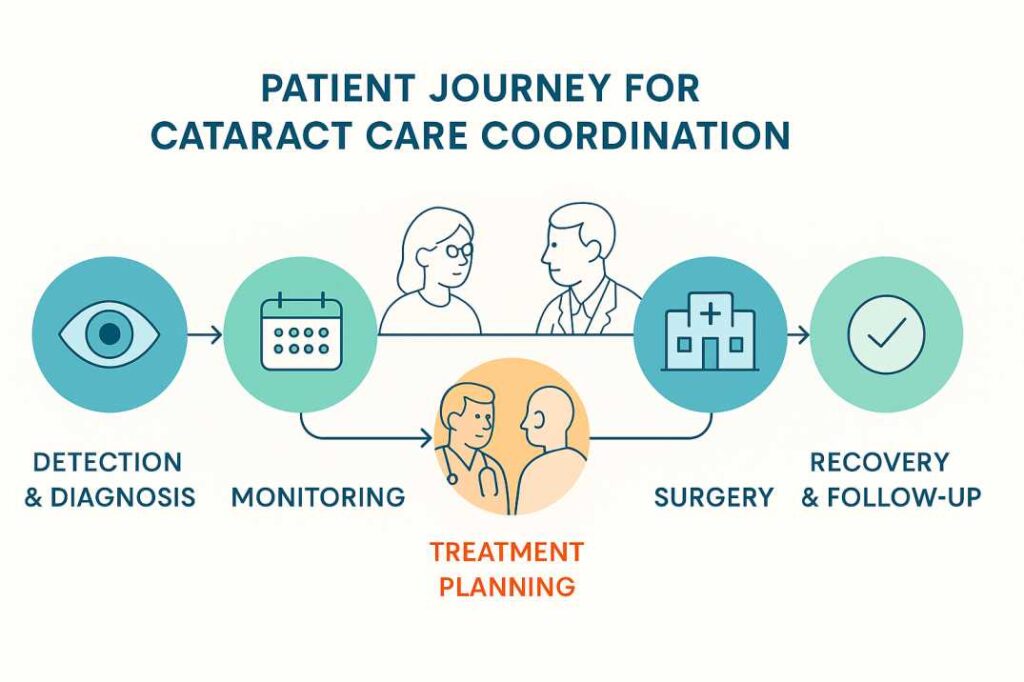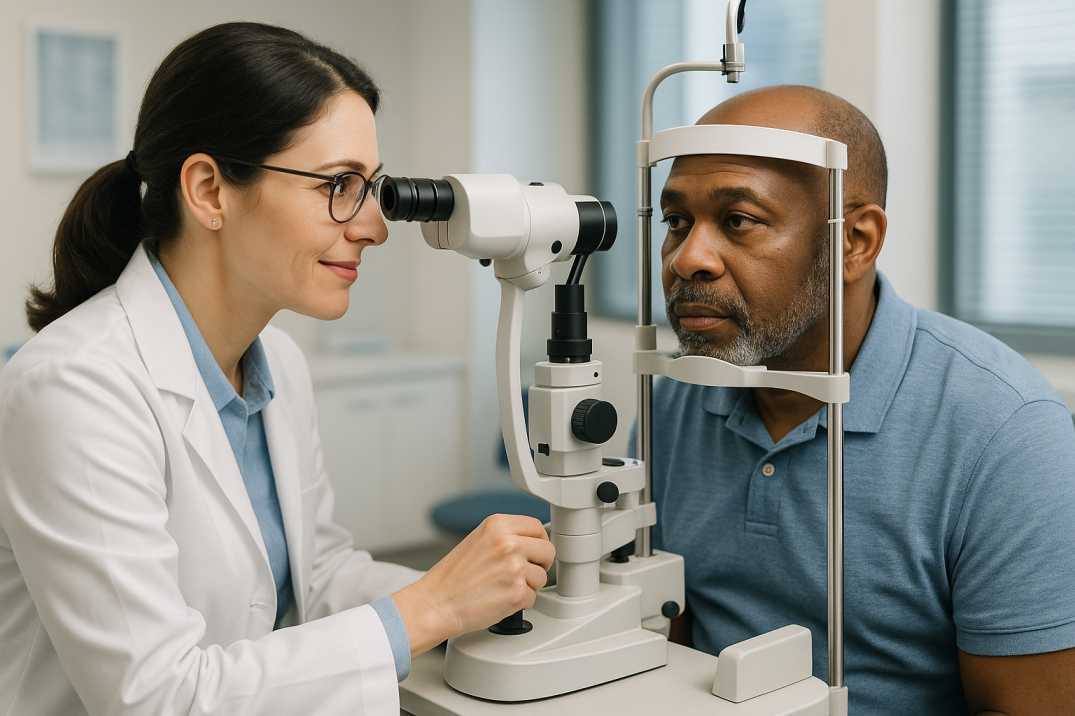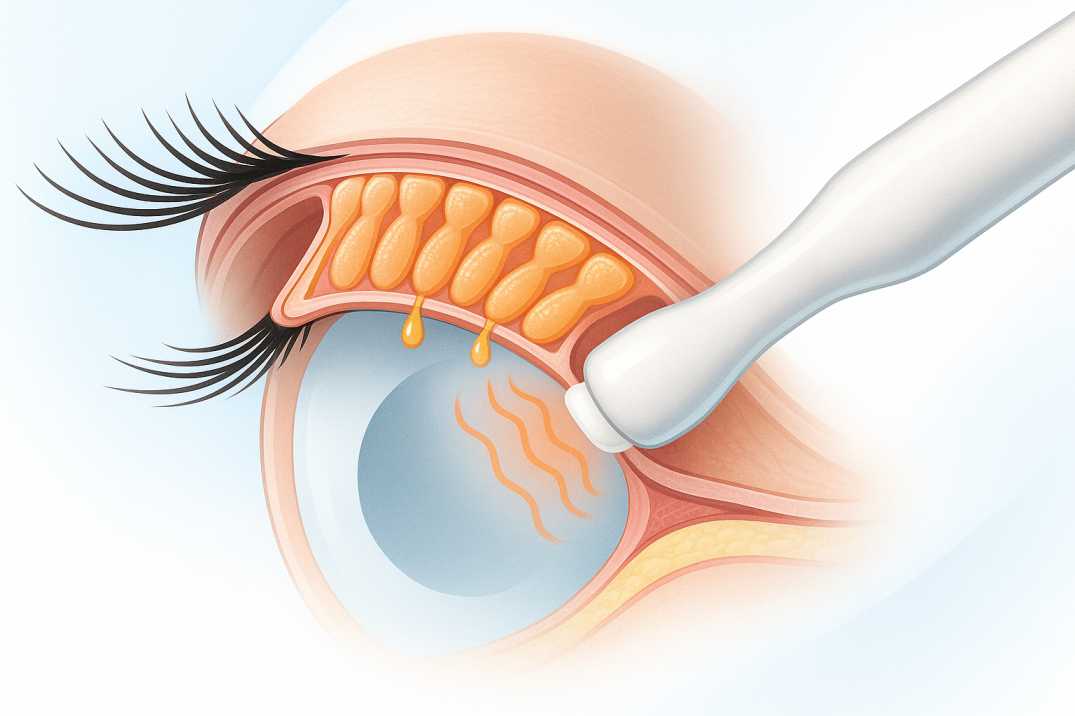Understanding Cataracts: Complete Detection & Treatment Guide
Understanding Cataracts: What You Need to Know
Imagine trying to read your favorite book through a foggy window. That’s what living with cataracts can feel like. More than half of Americans over 80 either have cataracts or have undergone surgery to restore their vision. Understanding this common eye condition is the first step toward maintaining clear, comfortable vision throughout your life.
In this comprehensive guide, you’ll learn:
- Early warning signs and symptoms of cataracts
- How cataracts are detected and monitored
- Modern surgical options and recovery expectations
- How to coordinate care between your eye doctors
- Latest research breakthroughs in cataract treatment
A cataract occurs when the normally clear lens inside your eye becomes cloudy, similar to looking through a frosted window. This clouding happens gradually as proteins in your lens break down and clump together, obscuring the passage of light to your retina. While cataracts primarily affect older adults, they can develop at any age due to various factors, including injury, certain medical conditions, or even congenital conditions.
Early Signs and Symptoms: When to Pay Attention
Common Warning Signs
Recognizing cataract symptoms early allows for better monitoring and timely intervention. Watch for these indicators:
- Blurry or cloudy vision that progressively worsens
- Increased sensitivity to glare, especially when driving at night
- Halos appearing around lights
- Colors appear faded or with a yellowish tint
- Difficulty reading in normal lighting conditions
- Double vision in one eye
- Frequent changes in eyeglass prescriptions
Many people don’t notice symptoms initially because cataracts develop slowly over months or years. You might find yourself holding reading materials farther away, needing brighter light for tasks, or experiencing more difficulty with night driving before realizing these changes signal a developing cataract.
The Progressive Nature of Cataracts
Cataracts develop through distinct stages. In the early incipient stage, the lens begins to cloud, causing minor visual disturbances. As the condition progresses to the intumescent stage, the cloudy area expands and the lens swells, further impairing vision. The mature stage brings significant opacity across the entire lens, substantially impacting daily activities. Finally, the hypermature stage can lead to complications, including glaucoma if left untreated.
Risk Factors: Who’s Most Susceptible?
Understanding your risk factors helps you take proactive steps toward prevention and early detection.
Age-Related Factors
Around age 40, the proteins in your eye’s lens naturally begin breaking down, with cataracts typically becoming noticeable in your fifth or sixth decade. Research indicates women have a slightly higher prevalence than men, with a ratio of approximately 1.3 to 1.
Lifestyle and Health Factors
- Smoking: Tobacco use significantly increases cataract risk
- UV Exposure: Prolonged sun exposure without protection damages lens proteins
- Diabetes: Elevated blood sugar levels accelerate cataract formation
- Hypertension and Hyperlipidemia: These conditions are often associated with increased cataract occurrence
- Obesity: particularly, central obesity correlates with a higher risk
- Steroid Use: Long-term corticosteroid use can trigger cataract development
- Eye Injuries: Previous trauma can lead to traumatic cataracts
- Poor Nutrition: Diets lacking in antioxidants and essential vitamins
Comprehensive Detection Methods
Professional Eye Examinations
Regular comprehensive eye exams are crucial for early cataract detection, often identifying issues before you notice symptoms. Schedule your comprehensive eye examination with an experienced optometrist who can track changes in your vision over time.
Visual Acuity Testing
Your eye doctor begins with a standard visual acuity test, asking you to read letters on a chart at various distances. This establishes baseline vision and tracks changes over time.
Slit-Lamp Examination
This specialized microscope provides a magnified view of your eye’s structures. By illuminating your eye with an intense line of light, your doctor can examine your lens in detail, identifying even subtle cloudiness.
Retinal Examination
After dilating your pupils with eye drops, your doctor examines the back of your eye, checking for cataracts and other conditions that might affect your vision. This complete evaluation ensures accurate diagnosis and appropriate treatment planning.
Advanced Diagnostic Technology
Modern eye care utilizes cutting-edge diagnostic equipment. AI-powered facial and ocular image analysis now enables early detection of cataracts alongside other vision-threatening conditions, allowing for more comprehensive preventive care.
Monitoring Your Cataract Progression
Establishing a Monitoring Schedule
Once diagnosed with cataracts, regular monitoring becomes essential. Your eye care professional will recommend an examination schedule based on the severity and progression rate of your cataract. Typical monitoring intervals range from every 6-12 months for early-stage cataracts to more frequent visits as symptoms worsen.
What to Track Between Appointments
Keep a journal noting changes in your vision:
- Activities that have become more difficult
- Lighting conditions that cause problems
- Any new visual symptoms
- Changes in your ability to perform daily tasks
When Monitoring Becomes Treatment Planning
In high-income regions, widespread access to cataract surgeries and regular eye health check-ups facilitates early detection and treatment. Your doctor will discuss surgery when cataracts significantly interfere with your quality of life, not simply when they’re present.
Treatment Coordination: Your Pathway to Clear Vision
Early-Stage Management
In the beginning, cataracts may not require immediate surgery. Your eye care team can help you manage symptoms through:
- Updated prescription glasses or contact lenses
- Anti-glare coatings on eyewear
- Improved lighting for reading and other tasks
- Magnifying lenses for detailed work
- Protective eyewear with UV protection
When Surgery Becomes Necessary
Surgery becomes the recommended option when cataracts prevent you from safely performing daily activities like reading, driving, or working. Cataract surgery has a success rate of 95-98%, with more than 9 out of 10 people achieving improved vision, making it one of the safest and most successful medical procedures performed today.
The Modern Surgical Approach
Today’s cataract surgery is remarkably advanced. The procedure typically takes just 10-15 minutes and involves:
- Making a tiny incision in your eye
- Using ultrasound energy (phacoemulsification) to break up the cloudy lens
- Removing the fragmented lens material
- Inserting a clear artificial intraocular lens (IOL)
Most patients experience minimal discomfort and notice vision improvement within days.
Advanced Intraocular Lens Options in 2025
The newest IOL options offer unprecedented opportunities for vision restoration and enhancement. Your choices include:
- Monofocal IOLs: Provide excellent vision at one distance
- Extended Depth of Focus (EDOF) IOLs: Offer good distance and intermediate vision with minimal glare
- Trifocal IOLs: Enable clear vision at all distances
- Toric IOLs: Correct astigmatism along with cataracts
- Light Adjustable Lenses: Allow post-surgery fine-tuning for optimal vision
Coordinating with Your Healthcare Team
Successful cataract management involves coordination among multiple healthcare professionals:
- Your primary care physician manages underlying health conditions affecting your eyes
- Your optometrist provides routine eye care and initial cataract detection
- Your ophthalmologist performs surgery and manages complex eye conditions
- Post-surgical care teams ensure optimal healing
This collaborative approach ensures comprehensive care tailored to your unique needs.
Post-Surgical Care and Recovery
What to Expect After Surgery
Vision may appear blurry immediately after surgery—this is completely normal. Most people notice improvement within a few days, with full recovery typically occurring within four weeks.
Essential Recovery Guidelines
- Use prescribed eye drops exactly as directed
- Wear your protective eye shield when sleeping
- Avoid rubbing or putting pressure on your eye
- Keep water, shampoo, and soap away from your eyes
- Wear sunglasses outdoors
- Avoid heavy lifting initially
- Attend all follow-up appointments
Follow-Up Schedule
Your surgical team will schedule specific follow-up appointments to monitor healing:
- First appointment: Usually the day after surgery
- Subsequent visits: Typically at one week, one month, and three months
- Long-term monitoring: Annual comprehensive eye exams
Recognizing Complications
While complications are rare, contact your eye doctor immediately if you experience:
- Sudden vision loss or significant blurring
- Persistent pain unrelieved by over-the-counter medication
- Increased redness or swelling
- Flashes of light or new floaters
- A curtain of shadow across your vision
Recent Research Breakthroughs
Emerging Non-Surgical Treatments
Researchers at the National Institutes of Health have identified a protein called RNF114 that reverses cataracts in animal studies, potentially representing a future surgery-free treatment option. This groundbreaking discovery offers hope for managing cataracts through drug therapy, particularly benefiting populations with limited access to surgical care.
Artificial Intelligence in Detection
The Alliance for Healthcare from the Eye launched in 2025 and aims to harness AI-powered analysis of ocular data to support earlier detection and expand access to care. These technological advances promise more efficient and accessible screening, particularly for underserved communities.
Improved Surgical Techniques
The integration of artificial intelligence into cataract surgery should ensure better outcomes through refined complication analysis and outcome prediction, allowing surgeons to tailor procedures to individual patients with unprecedented precision.
Prevention Strategies: Protecting Your Vision
While aging inevitably affects your eyes, you can take proactive steps to delay cataract development:
Lifestyle Modifications
- Quit smoking: Tobacco use is a major modifiable risk factor
- Protect from UV rays: Wear sunglasses with UV protection and wide-brimmed hats
- Maintain a healthy weight: Address obesity through balanced nutrition and regular exercise
- Control blood sugar: If you have diabetes, keep blood glucose levels well-managed
- Limit alcohol consumption: Excessive drinking may increase cataract risk
Nutritional Support
Consume a diet rich in:
- Antioxidants (vitamins C and E)
- Omega-3 fatty acids
- Lutein and zeaxanthin from leafy greens
- Colorful fruits and vegetables
- Fish high in omega-3s
Regular Eye Care
Schedule comprehensive eye examinations:
- Every 1-2 years for adults aged 40-54
- Every 1-2 years for adults aged 55-64
- Annually for adults 65 and older
- More frequently, if you have risk factors
Living with Cataracts: Quality of Life Considerations
Adapting Your Environment
While awaiting surgery or in early stages:
- Increase lighting in your home, especially for reading areas
- Use task lighting for detailed work
- Minimize glare by positioning light sources appropriately
- Consider large-print books and materials
- Use magnifying devices when needed
Safety Precautions
- Ensure adequate lighting on stairs and walkways
- Remove tripping hazards
- Install grab bars in bathrooms
- Consider limiting night driving if glare significantly affects vision
- Update prescriptions regularly
Emotional Support
Research shows that more than one-third of patients fear cataract surgery, with many specifically citing concerns about vision loss despite the procedure’s 95-98% success rate. These fears are understandable but often stem from misinformation. Open communication with your eye care team, connecting with others who’ve undergone surgery, and seeking counseling if anxiety persists can help ease concerns.
Insurance and Financial Considerations
Most insurance plans, including Medicare, cover medically necessary cataract surgery with standard monofocal lenses. Premium lens options that reduce glasses dependence may require out-of-pocket expenses. Discuss costs transparently with your eye care team to understand your options and make informed decisions aligned with your budget and vision goals.
Choosing Your Eye Care Provider
Look for a provider who offers:
- Comprehensive diagnostic capabilities
- Experienced surgical expertise
- State-of-the-art technology
- Personalized, unhurried care
- Clear communication about options and expectations
- Strong patient testimonials
- Coordinated care with other healthcare providers
- Convenient location and scheduling
At Cannon EyeCare in Seattle’s University Village and Pike Place Market locations, we combine Midwestern hospitality with expert eye care, providing the thorough, personalized attention you deserve. Our comprehensive approach ensures you receive not just treatment but a genuine partnership in your eye health journey.
Medical References and Resources
This comprehensive guide is based on current medical research and authoritative sources. Below are key references used in developing this article:
1. National Eye Institute – Cataracts Overview: Overview The
National Institutes of Health provides comprehensive, research-backed information on cataract symptoms, causes, and treatment options.
https://www.nei.nih.gov/learn-about-eye-health/eye-conditions-and-diseases/cataracts
2. NIH Research on RNF114 Protein for Cataract Treatment
Groundbreaking 2024 study published in the Journal of Clinical Investigation identifying a protein that reverses cataracts in animal models, representing potential future non-surgical treatment options.
https://www.nih.gov/news-events/news-releases/nih-led-studies-point-potential-development-cataract-drug
3. University of Cincinnati Study on Patient Fear and Cataract Surgery
Published May 2025 in the Journal of Clinical Ophthalmology, this research examined patient anxiety about cataract surgery despite its 95-98% success rate, highlighting the importance of patient education and emotional support.
https://www.uc.edu/news/articles/2025/04/uc-study–fear-may-deter-patients-from-cataract-surgery.html
Sources and Medical Review: This comprehensive guide incorporates the latest research from leading medical institutions, including the National Eye Institute, Journal of Clinical Investigation, and the American Academy of Ophthalmology. Information reflects current best practices as of 2025 for cataract detection, monitoring, and treatment coordination.
Taking the Next Step
If you’re experiencing vision changes or have been diagnosed with cataracts, don’t wait to seek expert care. Early detection and appropriate monitoring ensure optimal outcomes and maintain your quality of life.
Ready to protect your vision? Schedule a comprehensive eye examination with a trusted eye care professional today. Remember, cataracts are highly treatable, and modern surgical techniques offer excellent results with minimal disruption to your daily routine.
Your vision matters. Take control of your eye health journey with confidence, knowing that expert care and proven treatments can restore the clear, comfortable vision you deserve.
Contact Cannon EyeCare Today
📍 University Village Location
Schedule an appointment | Get directions
📍 Pike Place Market Location
Schedule an appointment | Get directions
📞 Call us
💻 Online booking: Book your eye exam now
FAQs
-
-
Cataracts are detected by a comprehensive eye exam, including vision testing and a slit-lamp examination to look for lens clouding.
-




